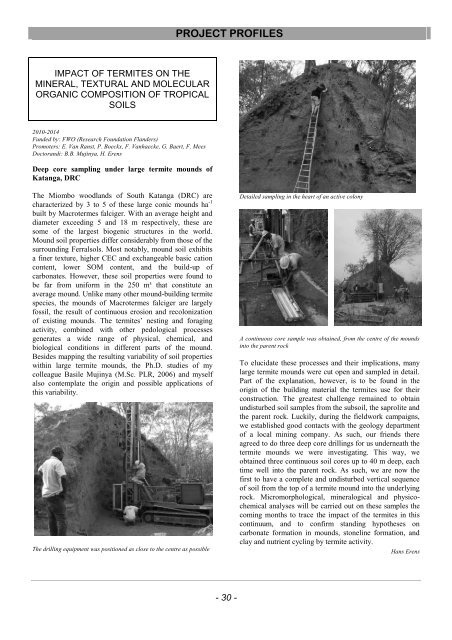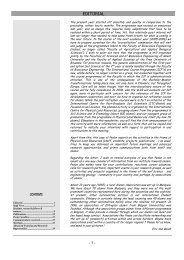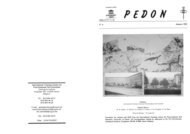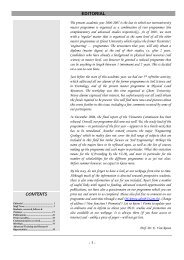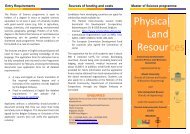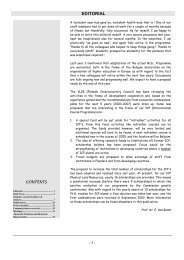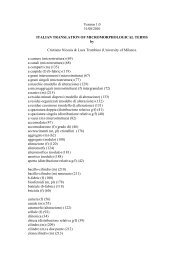Pedon 23 - Physical Land Resources - Universiteit Gent
Pedon 23 - Physical Land Resources - Universiteit Gent
Pedon 23 - Physical Land Resources - Universiteit Gent
You also want an ePaper? Increase the reach of your titles
YUMPU automatically turns print PDFs into web optimized ePapers that Google loves.
PROJECT PROFILES<br />
IMPACT OF TERMITES ON THE<br />
MINERAL, TEXTURAL AND MOLECULAR<br />
ORGANIC COMPOSITION OF TROPICAL<br />
SOILS<br />
2010-2014<br />
Funded by: FWO (Research Foundation Flanders)<br />
Promoters: E. Van Ranst, P. Boeckx, F. Vanhaecke, G. Baert, F. Mees<br />
Doctorandi: B.B. Mujinya, H. Erens<br />
Deep core sampling under large termite mounds of<br />
Katanga, DRC<br />
The Miombo woodlands of South Katanga (DRC) are<br />
characterized by 3 to 5 of these large conic mounds ha -1<br />
built by Macrotermes falciger. With an average height and<br />
diameter exceeding 5 and 18 m respectively, these are<br />
some of the largest biogenic structures in the world.<br />
Mound soil properties differ considerably from those of the<br />
surrounding Ferralsols. Most notably, mound soil exhibits<br />
a finer texture, higher CEC and exchangeable basic cation<br />
content, lower SOM content, and the build-up of<br />
carbonates. However, these soil properties were found to<br />
be far from uniform in the 250 m³ that constitute an<br />
average mound. Unlike many other mound-building termite<br />
species, the mounds of Macrotermes falciger are largely<br />
fossil, the result of continuous erosion and recolonization<br />
of existing mounds. The termites’ nesting and foraging<br />
activity, combined with other pedological processes<br />
generates a wide range of physical, chemical, and<br />
biological conditions in different parts of the mound.<br />
Besides mapping the resulting variability of soil properties<br />
within large termite mounds, the Ph.D. studies of my<br />
colleague Basile Mujinya (M.Sc. PLR, 2006) and myself<br />
also contemplate the origin and possible applications of<br />
this variability.<br />
The drilling equipment was positioned as close to the centre as possible<br />
Detailed sampling in the heart of an active colony<br />
A continuous core sample was obtained, from the centre of the mounds<br />
into the parent rock<br />
To elucidate these processes and their implications, many<br />
large termite mounds were cut open and sampled in detail.<br />
Part of the explanation, however, is to be found in the<br />
origin of the building material the termites use for their<br />
construction. The greatest challenge remained to obtain<br />
undisturbed soil samples from the subsoil, the saprolite and<br />
the parent rock. Luckily, during the fieldwork campaigns,<br />
we established good contacts with the geology department<br />
of a local mining company. As such, our friends there<br />
agreed to do three deep core drillings for us underneath the<br />
termite mounds we were investigating. This way, we<br />
obtained three continuous soil cores up to 40 m deep, each<br />
time well into the parent rock. As such, we are now the<br />
first to have a complete and undisturbed vertical sequence<br />
of soil from the top of a termite mound into the underlying<br />
rock. Micromorphological, mineralogical and physicochemical<br />
analyses will be carried out on these samples the<br />
coming months to trace the impact of the termites in this<br />
continuum, and to confirm standing hypotheses on<br />
carbonate formation in mounds, stoneline formation, and<br />
clay and nutrient cycling by termite activity.<br />
Hans Erens<br />
- 30 -


